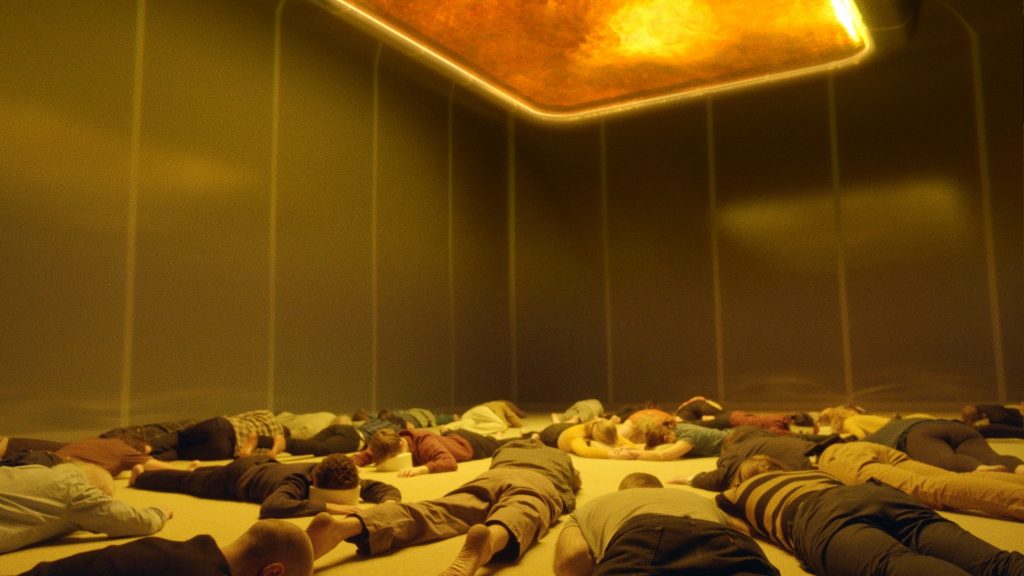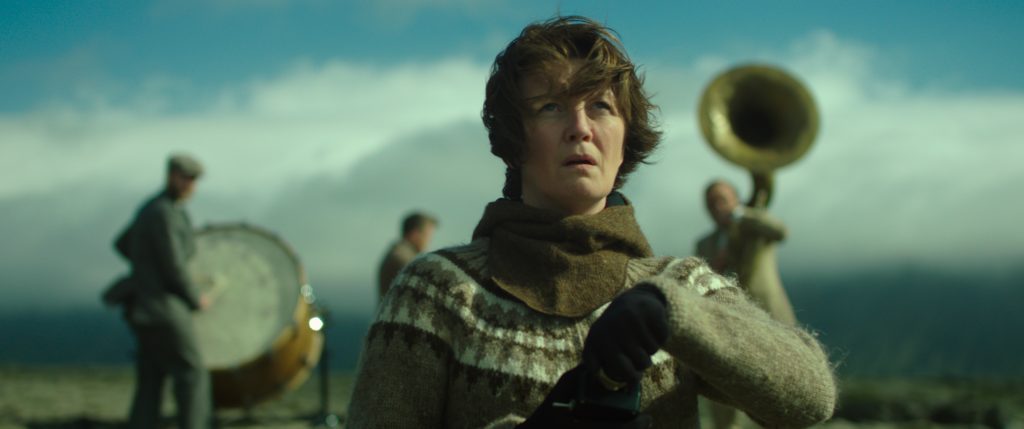“When we think of end times, we think of film.”
Göteborg Film Festival's Artistic Director Jonas Holmberg on the meaning of film in the age of climate crisis.
Göteborg Film Festival's Artistic Director Jonas Holmberg on the meaning of film in the age of climate crisis.
Apocalypse is the focus of Göteborg Film Festival 2019. The ongoing climate crisis can no longer be ignored. Film as an art form has since its beginning shaped our image of our extinction. In his essay, the Artistic Director of Göteborg Film Festival, Jonas Holmberg, writes about the film’s role in our apocalyptic age.
Words: Jonas Holmberg
“It’s like a movie,” the helicopter pilot said as the forest fire leaped among the tree tops outside Gällö i northern Sweden. “It’s all dead and black. Like a movie,” a woman from Ljusdal said as she returned home seven days after having fled the flames.
In mid-July 25,000 hectares of Swedish forest burned in the areas of Jämtland, Hälsingland and Älvdalen. It was the largest series of fires in Sweden since the nineteenth century, and as we watched the fire we wondered what was happening. We sensed the apocalypse, it seemed familiar.
When we think of end times, we think of film. When we see catastrophes, they look like film. From the natural catastrophes in Armageddon, Deep Impact or The Day After Tomorrow to the post-apocalyptic landscapes in La Jetée, Mad Max or The Road, film is the art form that has devoted itself to the apocalypse and formed our notions about what it will look like. Collapsing skyscrapers, charred landscapes.
“Each film creates a world that ends after two hours.”
Do you remember how films used to end? First things went black. Then quiet. Then a simple text: The End. Fin. Each film creates a world that ends after two hours.
Perhaps it is not so strange that the film industry, more than anything else, has helped us conceive of the unthinkable. Film is the foremost cultural expression of modernity, it is the art form of massive machines and capitalist mass-production. And isn’t it precisely this careening modernity that is the problem? Isn’t it precisely this unsustainable economy that pushes us closer and closer to the apocalypse?
This is in any case the claim made by the researchers behind a recently published background document to the forthcoming UN report “Global Sustainable Development Report 2019,” which establishes that the economic-political logic driving global development is completely disconnected from the ecological framework predicating the economy itself. Both liberal democracies and authoritarians regimes are fueling the engine of growth and cruising straight for the cliff. The fires, the storms, and the floods are just the beginning. The vehicle seems to lack brakes.

Melancholia © 2011 – Magnolia Pictures
Lars von Trier’s doomsday scenario, Melancholia, begins with a telling picture of the situation. A limousine approaches Tjolöholm Castle. Kirsten Dunst and Alexander Skarsgård play a young couple who are on their way to the wedding feast, but their lustrous ride gets stuck on a narrow lane. The chauffeur is unable to free the vehicle from a hairpin turn—the limo is too long. This is a picture of a vulgarized modernity that no longer works in relation to its surrounding environment. Catastrophe is nigh, from both inside and out. The infatuated couple in the backseat does not yet know it: at the same time as their modern project has run aground, an enormous planet is hurling through space. This super planet is steadily approaching Earth. The party will not end well.
Melancholia is one of the best, but film history is full of films about the apocalypse. Already in 1916, von Trier’s compatriot August Blom directed one of the genre’s first films, and just like Melancholia, his silent film The End of the World combines existential unrest with social critique in a story where both Earth and the revels of the upper class are dashed by an astronomic collision. During the Interwar Period, Hollywood produced apocalyptic films such as The Last Man on Earth and Deluge, but the genre really took off after the rise of the atomic bombs that fell upon Hiroshima and Nagasaki, as mankind first showed its autonomous capacity to incite complete destruction. The subtitle of Stanley Kubrick’s apocalyptic comedy Dr. Strangelove summarizes one of the possible approaches to the existential challenge of the Post-War Era: How I Learned to Stop Worrying and Love the Bomb.

Aniara. Directors: Pella Kågerman och Hugo Lilja
Harry Martinson assumed a less-ironic position. He published his masterpiece Aniara in 1956, amidst Cold War fears of radioactive catastrophe. He was deeply affected by Hiroshima, and was unable to come to terms with his worries about the total atomic war that threatened to eradicate all human existence. In the poetic epic Aniara, Martinson describes one of several thousand spaceships fleeing an Earth ruined by nuclear catastrophe and heading for Mars. Aniara is a warning call to the immediate surroundings and a story deeply anchored in its time, but it also points ahead and ties the end of the world to humanity’s enduring flaws.
As Pella Kågerman and Hugo Lilja now return to Aniara, the Wall has fallen and nuclear war has temporarily been averted. But the apocalyptic mood has returned, showing symptoms of a coming climate catastrophe: heat records, extreme weather, and melting polar ice. Instead of the atomic bombs’ abrupt 3,000-degree heat, we dread a two-degree temperature increase, which according the Paris Agreement, must not occur. But if mass-consumption of goods and energy continues, the goal to avoid a two-degree increase will never be achieved.
Which is why it is completely natural that the spaceship in Kågerman and Lilja’s Aniara is portrayed as a shopping center. The film was recorded at Sollentuna Galleria and Mall of Scandinavia, themselves symbols of modern capitalism that seems incapable of reining in the development. But for Kågerman and Lilja, it is mankind, its dreams and shortcomings, that are in focus.
The film is not without fascinating interplanetary exteriors, but it is Arvin Kananian’s role as an imperious captain, Emelie Jonsson’s role as a compassionate but fading hostess, and the increasingly desperate passengers, that evoke the film’s dramatic thrills and supply its philosophical power. Martinson summed up the situation in Aniara’s 26th canto:
“There is shelter from nearly all that is
from fire and spoilage of storms and ice
yes, count the blows that come to mind.
But there is no shelter from mankind.”
Does Earth need protection from mankind? While Italian airtankers and Polish firetrucks fought to extinguish the fires in the Swedish forests, researches across the world initiated an intensive debate about geological news. Geology is a slow subject that normally does not lend itself to inflammatory exchanges in global media or even give rise to much news at all. But this summer things were different. This time it was a matter of the survival of Earth.
“It is no longer tectonic plates or volcanoes that have the greatest impact on Earth’s development. It is mankind.”
Over the last decade, more and more geological researchers have argued that we live in a time called the Anthropocene. It is a concept characterizing the period in which mankind—through agriculture, industry and nuclear technology—has left ineradicable marks on the planet. It is no longer tectonic plates or volcanoes that have the greatest impact on Earth’s development. It is mankind.
The organization that formally names geological eras is called the International Commission on Stratigraphy (ICS), and may perhaps, until now, have mostly been known for the Jurassic, their definition of a period 200 million years ago, which was popularized through Steven Spielberg’s Jurassic Park. But in July, as ICS suddenly announced that we live in a new geological age called the Meghalayn—a term no one had previously heard—and said nothing of the Anthropocene, many were surprised and angered. Certain researchers described the decision as a coup of climate skeptics, which undermined the severity of a situation requiring immediate and extensive political action.

Woman at War. Director: Benedikt Erlingsson
As a strictly scientific organization, ICS may have wished to avoid political alarmism this time around, but we who have seen many catastrophe films know that a geologist is needed to send out warning and ensure that the threat is taken seriously. In the catastrophe king Roland Emmerich’s film 2012, Chiwetel Ejiofor plays the role of a geologist who realizes that the Earth’s core is overheating. Ultimately the U.S. president has to act. In Dante’s Peak, Pierce Brosnan plays a geologist trying to make the inhabitants at the foot of a mountain understand that the nearby sleeping volcano has awoken, and in John Andreas Andersen’s recent The Quake, Kristoffer Joner’s role as a scruff geologist fills the same warning function. What the films have in common is that the geologists’ warnings come too late and are too weak. Catastrophe comes anyhow.
If geologists are too cautious, we still have to rely on the activists. This year’s most fun and twisted “cli-fi” is about the terrorist activities of a lone, radicalized climate activist. Director Benedikt Erlingsson’s Woman at War shines with its perfectly pitched and uniquely twisted story about a woman who is not satisfied by shouting out at politicians and business executives. She picks up a bow, rests it on her shoulder, and takes things into her own hands.
“There is a crisis of imagination at bottom of the political paralysis in the face of the climate crisis.”
The theatergoing climate researchers’ standard critique of films about environmental catastrophes—that they focus on a lone hero’s struggle when in reality far-reaching collective action is needed—can also be leveled at Woman at War. But the light-hearted extremism in Erlingsson’s heroic saga about a choir leader who turns into a resistance woman, elicits a new emotional place from which to contemplate climate issues.
We need such places. There is a crisis of imagination at bottom of the political paralysis in the face of the climate crisis. We have all seen the numbers, the diagrams, and the prognoses. We are aware, but our emotional responses are dominated by resigned passivity or aggressive rebuke. Except in a few fleeting instances—as when the tongues of forest fires suddenly lick the eaves of our homes—mankind seems unable to veritably imagine what is about to happen, and even less so draw up an alternative to the societal order ingrained with its own demise. Although the UN is warning the public about the market forces killing the planet, we are incapable of thinking of any other driving force.
But if there any human invention that has the potential to expand the minds of the masses and the imagination, then it is film. Whether film has formulated our notions of the apocalypse, it is film that can deal with and negotiate the ethics and aesthetics of looming destruction. If there is a light, perhaps it comes from the projector.
Close